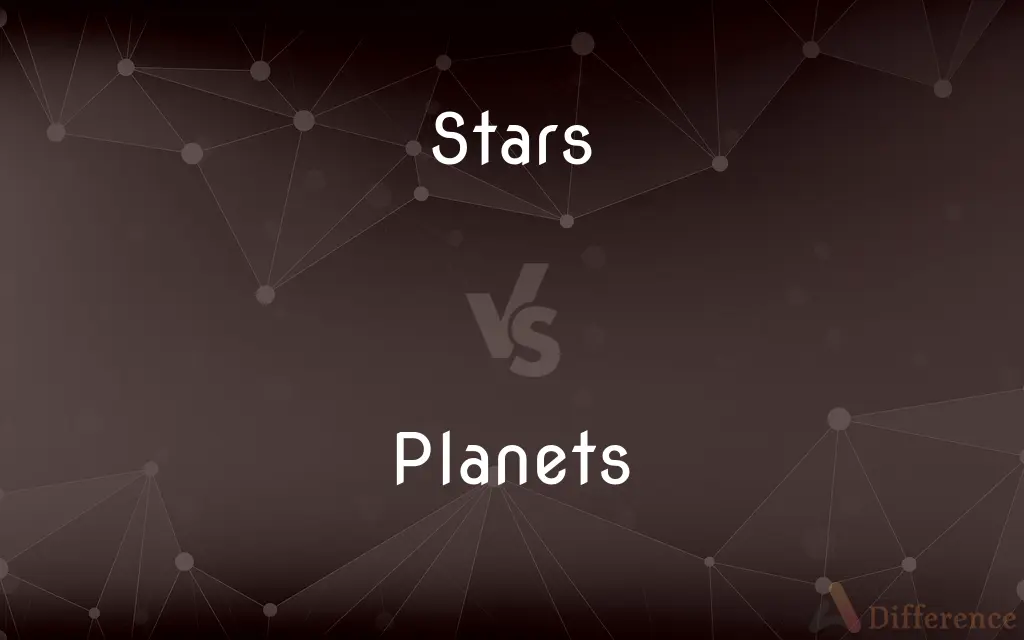Stars vs. Planets — What's the Difference?
Edited by Tayyaba Rehman — By Fiza Rafique — Published on December 14, 2023
Stars are luminous celestial bodies that produce light and heat via nuclear fusion, while Planets are non-luminous celestial bodies that orbit stars.

Difference Between Stars and Planets
Table of Contents
ADVERTISEMENT
Key Differences
Stars are essentially massive, glowing balls of gas, primarily composed of hydrogen and helium. These celestial bodies undergo nuclear fusion in their cores, producing immense heat and light in the process. In contrast, Planets do not emit their own light but reflect the light from the stars they orbit. While Stars generate energy, Planets are primarily recipients of this energy.
When observing the vast expanse of the universe, Stars stand out as bright, twinkling points in the night sky. They are often many times larger than Planets and have a life cycle that can span billions of years. Planets, on the other hand, are often found in a variety of sizes, from dwarf planets to gas giants, and they do not twinkle in the night sky like Stars do.
The origin and formation of Stars and Planets also differ. Stars are born from collapsing clouds of gas and dust, eventually reaching temperatures high enough to trigger nuclear fusion. Planets, conversely, form from the leftover material that orbits around young stars. This material gradually clumps together, leading to the creation of Planets.
It's essential to understand that Stars are the primary energy sources in the universe, driving many cosmic processes. They play a crucial role in the formation and sustenance of planetary systems. Planets, being secondary bodies, depend on Stars for illumination and, in many cases, for the conditions necessary for life.
Comparison Chart
Composition
Primarily hydrogen and helium
Varies (rock, gas, ice, etc.)
ADVERTISEMENT
Light Emission
Emit their own light due to nuclear fusion
Reflect light from stars
Formation
From collapsing gas and dust clouds
From leftover material around young stars
Role in Universe
Primary energy sources, drive cosmic processes
Secondary bodies, depend on stars
Twinkling
Twinkle due to Earth's atmosphere affecting their light
Do not twinkle
Compare with Definitions
Stars
Massive gas balls primarily made of hydrogen and helium.
Stars like our sun are essential for sustaining life on planets.
Planets
Objects that can be rocky, gaseous, or icy in composition.
Among the Planets, Jupiter is known as a gas giant.
Stars
Celestial bodies that can have planets orbiting them.
The number of Stars in our galaxy alone is staggering.
Planets
Celestial bodies orbiting stars without producing their own light.
Earth is one of the eight Planets in our solar system.
Stars
Energy-providing entities in the universe.
Stars have a life cycle that includes stages like supernovas.
Planets
Bodies that move in defined orbits around stars.
Planets in our solar system have diverse and intriguing environments.
Stars
A celestial body that generates light and other radiant energy and consists of a mass of gas held together by its own gravity in which the energy generated by nuclear reactions in the interior is balanced by the outflow of energy to the surface, and the inward-directed gravitational forces are balanced by the outward-directed gas and radiation pressures.
Planets
Secondary bodies in a star system that reflect starlight.
Planets in the habitable zone of stars might host life.
Stars
Any of the celestial bodies visible at night from Earth as relatively stationary, usually twinkling points of light.
Planets
Entities that can have their own set of moons.
Some Planets, like Mars, have more than one moon.
Stars
Something regarded as resembling such a celestial body.
Planets
In the traditional model of solar systems, a celestial body larger than an asteroid or comet, illuminated by light from a star, such as the sun, around which it revolves.
Stars
A graphic design having five or more radiating points, often used as a symbol of rank or merit.
Planets
A celestial body that orbits the sun, has sufficient mass to assume nearly a round shape, clears out dust and debris from the neighborhood around its orbit, and is not a satellite of another planet.
Stars
An artistic performer or athlete whose leading role or superior performance is acknowledged.
Planets
One of the seven celestial bodies, Mercury, Venus, the moon, the sun, Mars, Jupiter, and Saturn, visible to the naked eye and thought by ancient astronomers to revolve in the heavens about a fixed Earth and among fixed stars.
Stars
One who is highly celebrated in a field or profession.
Planets
The collection of life forms supported on Earth
An asteroid that threatened the whole planet.
Stars
An asterisk (*).
Planets
People as a whole; humankind or the general public
The entire planet was affected by the global recession.
Stars
The star key on a telephone
For customer service, press star.
Planets
One of the seven revolving astrological celestial bodies that in conjunction with the stars are believed to influence human affairs and personalities.
Stars
A white spot on the forehead of a horse.
Planets
Plural of planet
Stars
A planet or constellation of the zodiac believed in astrology to influence personal destiny.
Stars
Stars The future; destiny. Often used with the.
Stars
Outstanding or famous, especially in performing something
A star researcher.
A star figure skater.
Stars
Of or relating to a star or stars.
Stars
To ornament with stars.
Stars
To award or mark with a star for excellence.
Stars
To mark with an asterisk.
Stars
To present or feature (a performer) in a leading role.
Stars
To play the leading role in a theatrical or film production.
Stars
To do an outstanding job; perform excellently.
Stars
Plural of star
Stars
(with "the") Outer space.
Stars
Luminous celestial bodies undergoing nuclear fusion.
The night sky is adorned with millions of Stars.
Stars
Objects that have their own life cycle, from birth to death.
Observing dying Stars can provide insight into the fate of our own sun.
Common Curiosities
Can Planets have life?
While Earth is the only known Planet with life, other Planets or their moons may potentially harbor life.
Why do Stars twinkle, but Planets don't?
Stars twinkle due to Earth's atmosphere distorting their distant light, whereas Planets appear steadier as they're closer.
Do all Planets have moons?
No, not all Planets have moons. For instance, Mercury and Venus lack moons.
Are all Stars similar to our sun?
No, Stars vary in size, temperature, and brightness. Our sun is a medium-sized star.
What makes Stars shine?
Stars shine due to nuclear fusion in their cores, converting hydrogen to helium and releasing energy.
Do Stars have a lifespan?
Yes, Stars have a lifecycle, from birth in nebulae to death as white dwarfs, neutron stars, or black holes.
How are Planets classified in our solar system?
Planets in our solar system are classified as terrestrial (rocky) or gas giants.
How do Stars and Planets form?
Stars form from collapsing gas and dust clouds, while Planets form from material left around young stars.
Are there Planets outside our solar system?
Yes, Planets outside our solar system are called exoplanets, and thousands have been discovered.
Do all Planets orbit Stars?
Most Planets orbit Stars, but there are "rogue Planets" that float freely in space without a star.
Can Planets produce their own light?
Planets do not produce their own light but reflect the light from the Stars they orbit.
Are Stars stationary in space?
No, Stars move in the galaxy, orbiting the galactic center. Our sun, for instance, orbits the Milky Way's center.
Can Planets influence the life cycle of Stars?
No, the life cycle of Stars is primarily determined by their mass and not by the Planets orbiting them.
What determines the number of Planets around a star?
Various factors, including the star's mass and the material present in its protoplanetary disk, determine the number of Planets.
How big can Stars get?
Stars can be colossal, with the largest known being over 1,500 times the sun's radius.
Share Your Discovery

Previous Comparison
1 Butanol vs. 2 Butanol
Next Comparison
Infrared Cooker vs. Induction CookerAuthor Spotlight
Written by
Fiza RafiqueFiza Rafique is a skilled content writer at AskDifference.com, where she meticulously refines and enhances written pieces. Drawing from her vast editorial expertise, Fiza ensures clarity, accuracy, and precision in every article. Passionate about language, she continually seeks to elevate the quality of content for readers worldwide.
Edited by
Tayyaba RehmanTayyaba Rehman is a distinguished writer, currently serving as a primary contributor to askdifference.com. As a researcher in semantics and etymology, Tayyaba's passion for the complexity of languages and their distinctions has found a perfect home on the platform. Tayyaba delves into the intricacies of language, distinguishing between commonly confused words and phrases, thereby providing clarity for readers worldwide.











































